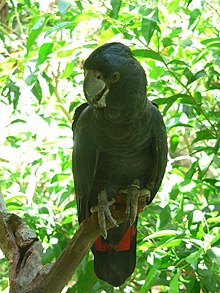Calyptorhynchus
| Calyptorhynchus | |
|---|---|

| |
| Calyptorhynchus banksii | |
| Scientific classification | |
| Domain: | Eukaryota |
| Kingdom: | Animalia |
| Phylum: | Chordata |
| Class: | Aves |
| Order: | Psittaciformes |
| Family: | Cacatuidae |
| Subfamily: | Calyptorhynchinae Bonaparte, 1853 |
| Genus: | Calyptorhynchus Desmarest, 1826 |
| Species | |
|
5, in two subgenera | |
Described by French naturalist Anselme Gaëtan Desmarest in 1826,[1] the genus Calyptorhynchus has five species. They are all mostly black in colour, and the taxa may be differentiated partly by size and partly by small areas of red, grey and yellow plumage especially in the tail feathers. It is the sole genus of the "dark cockatoo" subfamily Calyptorhynchinae. Studies based on the mitochondrial DNA 12S gene fragment suggested that other sexually dichromatic species, the gang-gang cockatoo as well as the cockatiel may be the closest living relatives of Calyptorhynchus (Brown & Toft, 1999). However, subsequent studies, including more genes confirm the morphological taxonomy with the gang-gang cockatoo most closely related to the Galah, within the white cockatoo group, and with the cockatiel as a third distinct subfamily of cockatoos.[2] Two subgenera (Calyptorhynchus and Zanda) are recognized based on the colouration of the species, and presence of sexual dimorphism:
- Subgenus Calyptorhynchus - black-and-red cockatoos
- Red-tailed black cockatoo, Calyptorhynchus (Calyptorhynchus) banksii
- Calyptorhynchus (Calyptorhynchus) banksii banksii
- Calyptorhynchus (Calyptorhynchus) banksii graptogyne
- Calyptorhynchus (Calyptorhynchus) banksii macrorhynchus
- Calyptorhynchus (Calyptorhynchus) banksii naso
- Calyptorhynchus (Calyptorhynchus) banksii samueli
- Glossy black cockatoo, Calyptorhynchus (Calyptorhynchus) lathami
- Calyptorhynchus (Calyptorhynchus) lathami lathami
- Calyptorhynchus (Calyptorhynchus) lathami erebus
- Calyptorhynchus (Calyptorhynchus) lathami halmaturinus
- Red-tailed black cockatoo, Calyptorhynchus (Calyptorhynchus) banksii
- Subgenus Zanda - black-and-yellow/white cockatoos
- Yellow-tailed black cockatoo, Calyptorhynchus (Zanda) funereus
- Calyptorhynchus (Zanda) funereus funereus
- Calyptorhynchus (Zanda) funereus whiteae (not widely accepted)[3]
- Calyptorhynchus (Zanda) funereus xanthanotus
- Carnaby's black cockatoo, Calyptorhynchus (Zanda) latirostris
- Baudin's black cockatoo, Calyptorhynchus (Zanda) baudinii
- Yellow-tailed black cockatoo, Calyptorhynchus (Zanda) funereus
References
- ^ Desmarest, Anselme Gaëtan (1826). "Parrots". Dictionnaire des Sciences Naturelles dans lequel on traite méthodiquement des différens êtres de la nature... (in French). Vol. 39 (PEROQ–PHOQ). Strasbourg: F.G. Levrault. pp. 21, 117. OCLC 4345179.
{{cite book}}: Unknown parameter|trans_chapter=ignored (|trans-chapter=suggested) (help); Unknown parameter|trans_title=ignored (|trans-title=suggested) (help) - ^ White, Nicole E.; et al. (2011). "The evolutionary history of cockatoos (Aves: Psittaciformes: Cacatuidae)". Molecular Phylogenetics and Evolution. 59: 615–622. doi:10.1016/j.ympev.2011.03.011. PMID 21419232.
- ^ Higgins, p. 76.
- Astuti, Dwi (2004?): A phylogeny of cockatoos (Aves: Psittaciformes) inferred from DNA sequences of the seventh intron of nuclear β-fibrinogen gene. Doctoral work, Graduate School of Environmental Earth Science, Hokkaido University, Japan. PDF fulltext
- Brown, D.M.; Toft, C.A. (1999). "Molecular systematics and biogeography of the cockatoos (Psittaciformes: Cacatuidae)". Auk. 116 (1): 141–157. doi:10.2307/4089461.
- Higgins, P.J. (1999). Handbook of Australian, New Zealand and Antarctic Birds. Volume 4: Parrots to Dollarbird. Melbourne: Oxford University Press. ISBN 0-19-553071-3.
